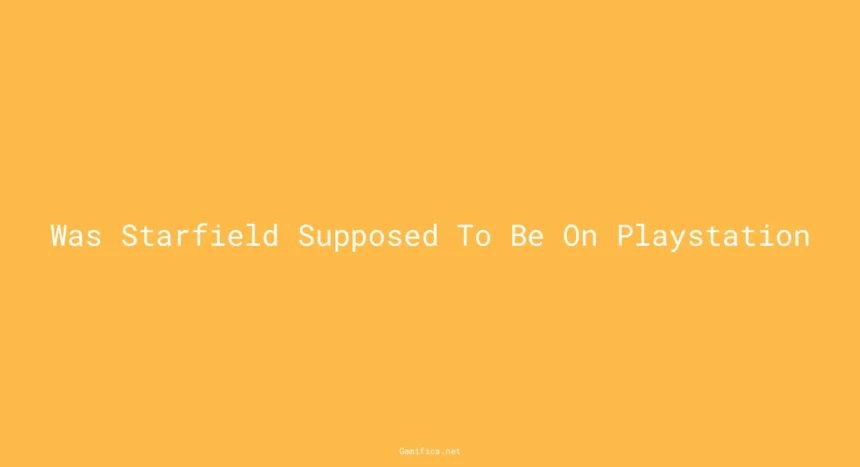Are you ready to blast off into a new galaxy of gaming? Well, get ready to buckle up because we’re diving into the fascinating world of Starfield! In this blog post, we’ll be uncovering the truth behind the platform exclusivity of this highly anticipated game. So, grab your spacesuit and let’s explore whether Starfield was ever supposed to be on Playstation.
The Evolution of Starfield’s Platform Exclusivity
Within the cosmos of gaming releases, Starfield shines as a beacon of anticipation. Gamers around the globe have been pondering a critical question: Was Starfield ever destined for the PlayStation? Unraveling this enigma requires delving into a saga of corporate maneuvers, exclusivity pacts, and evolving release plans.
Starfield’s Initial Announcement
At the dawning of its journey, Starfield was heralded as a multi-platform wonder, with the PlayStation among its intended destinations. Bethesda, then a sovereign studio, envisioned a universe where Starfield’s reach spanned across diverse gaming consoles, embodying their philosophy of broad accessibility.
Microsoft Acquires ZeniMax Media
Yet, the stars aligned differently when Microsoft emerged as the new guardian of ZeniMax Media, the celestial body governing Bethesda. This pivotal moment reshaped the destinies of many games, with Starfield’s trajectory being steered towards exclusivity. Under Microsoft’s domain, it was decreed that the game would grace only the realms of Xbox and PC, eclipsing any prospects of a PS5 odyssey.
This strategic shift was not merely a footnote in gaming history but a seismic event that would define the future of console exclusivity. The move signaled a new era where titans like Microsoft would leverage high-profile acquisitions to bolster their gaming ecosystems, and in doing so, transform the market landscape.
| Fact | Details |
|---|---|
| Starfield on PS5? | Unlikely post-Microsoft’s acquisition of ZeniMax Media |
| Starfield’s Initial Plan | Intended to launch on multiple platforms including PlayStation |
Microsoft’s bold move not only secured a jewel in their crown but also fanned the flames of platform competition, igniting discussions and speculations within the gaming community. The acquisition, valued at $7.5 billion, was not just a financial transaction but a strategic play that would have ripple effects across the industry.
Despite the longing of PlayStation loyalists to navigate the cosmic expanse of Starfield, Microsoft’s grand vision saw the game as a cornerstone for strengthening their own galactic empire—the Xbox Series X/S and PC gaming realms. It was a clear signal of intent; a decisive step towards dominating the next frontier in the console wars.
With this acquisition, Microsoft not only bolstered their exclusive game lineup but also sent a message to competitors and gamers alike: the future of gaming is not just about the games themselves, but also about where and how they can be played. Starfield became a symbol of this new paradigm—a star caught in the gravitational pull of industry giants, its path forever altered by the forces of corporate strategy.
Indeed, the fate of Starfield serves as a poignant reminder of the ever-changing nature of the gaming industry, where allegiances and strategies can shift as swiftly as the stars in the night sky.
Sony’s Interest in Starfield
In the high-stakes game of platform exclusivity, the tale of Starfield‘s allegiance is a saga marked by corporate chess moves. Sony, known for securing exclusive titles to bolster its PlayStation platform, eyed Starfield with keen interest. Their intention was clear: to make Starfield a glittering jewel in the PlayStation crown, potentially as a platform exclusive that would sway gamers to their ecosystem.
This strategic play by Sony, however, was met with a decisive counter by Microsoft. With swift and assertive action, Microsoft laid down a staggering $7.5 billion to acquire ZeniMax Media, ensuring that Starfield’s destiny was rerouted to enrich the Xbox and PC gaming landscape exclusively. This move not only thwarted Sony’s ambitions but also signaled a monumental shift in the gaming industry’s power dynamics.
The repercussions of this acquisition are profound, extending far beyond the realms of console exclusivity. It’s a testament to the lengths that titans of the industry will go to secure top-tier content for their platforms. For gamers, this maneuver by Microsoft means that Starfield’s expansive universe will be a narrative they’ll explore solely through the lens of Xbox and PC gaming experiences.
Starfield on Xbox Series X/S and Xbox One
With its release, Starfield shines not only on the cutting-edge Xbox Series X/S but also illuminates the gaming space for those still harboring the venerable Xbox One. This is made possible through the magic of cloud streaming, a technology that Microsoft has been ardently championing. It allows for the latest games to be played on older consoles without the need for hardware upgrades, democratizing access to new gaming experiences.
Through this cloud-based gaming solution, even those with a console from as far back as 2013 can jump into the cockpit of their starship and carve out their destiny among the stars. This move is a clear demonstration of Microsoft’s dedication to backward compatibility and their commitment to sustaining an inclusive gaming ecosystem that spans across multiple generations of consoles.
As the anticipation for Starfield continues to build, it stands as a beacon of Microsoft’s forward-thinking approach to gaming. It not only highlights the company’s investment in cloud technology but also underscores their strategy to leverage exclusive content to attract and retain gamers within their orbit.
Conclusion
Contemplating the fate of Starfield in the realm of console exclusivity sparks an intriguing question: was it destined to grace the PlayStation platform? The answer, though once affirmative, shifted dramatically with the tides of the gaming industry. The seismic event of Microsoft’s acquisition of ZeniMax Media altered the course, transforming Starfield’s trajectory into a beacon for the Xbox and PC gaming community.
In the heated race for exclusive content, Sony’s vision of Starfield as a PlayStation flagship title was eclipsed by Microsoft’s strategic maneuver. This acquisition was not merely a power play but a testament to the volatile nature of the gaming sector, where alliances and plans can pivot with the stroke of a corporate pen.
Now, as Starfield takes its place in the constellation of Xbox exclusives, players on the green-and-black side of the console divide will have the opportunity to traverse its vast universe. It’s a scenario that underscores the importance of industry dynamics and how they influence the availability of games across platforms. For those intrigued by the initial intentions and the subsequent corporate chess moves, a deeper dive into Starfield’s original announcement and Sony’s aspirations can be found in earlier sections of this discourse.
As we look to the stars, let us acknowledge that while Starfield’s journey to release has been as enigmatic as the cosmos itself, it ultimately serves as a vivid illustration of the ever-evolving narrative of gaming exclusivity.
FAQ
Q: Was Starfield originally supposed to be on PlayStation?
A: Yes, Starfield was originally supposed to be on PlayStation.
Q: Was Starfield originally announced for PlayStation?
A: Yes, Starfield was announced before Bethesda was acquired and it was likely aiming for multiple platforms, including PlayStation.
Q: Is Starfield an Xbox exclusive?
A: Yes, Starfield is now considered an Xbox exclusive.
Q: Was Redfall also planned for PlayStation?
A: Yes, Redfall was initially in production for PlayStation, but Microsoft allegedly canceled it.







